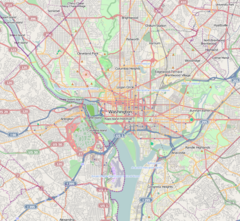
William McKinley was an American politician who served as the 25th president of the United States from 1897 until his assassination in 1901. A member of the Republican Party, he led a realignment that made Republicans largely dominant in the industrial states and nationwide for decades. He presided over victory in the Spanish–American War of 1898; gained control of Hawaii, Puerto Rico, the Philippines and Cuba; restored prosperity after a deep depression; rejected the inflationary monetary policy of free silver, keeping the nation on the gold standard; and raised protective tariffs.

President William McKinley High School, more commonly referred to as McKinley High School, is a comprehensive public high school in the Honolulu District of the Hawaii State Department of Education. It serves grades nine through twelve. McKinley is one of three schools in the Kaimuki-McKinley-Roosevelt Complex Area which includes Kaimuki High School and Roosevelt High School. It was founded as Fort Street English Day School in 1865. Later known as Honolulu High School, it was renamed in memorial to William McKinley, the twenty-fifth President of the United States, in 1907. President William McKinley High School is one of the oldest secondary schools in the state and several of its buildings have been listed on the National Register of Historic Places. The campus displays sculptures by Satoru Abe (1926–) and Bumpei Akaji (1921–2002). McKinley High School is accredited by the Western Association of Schools and Colleges.

The McKinley National Memorial in Canton, Ohio, United States, is the final resting place of William McKinley, who served as the 25th president of the United States from 1897 to his assassination in 1901. Canton was a significant place in McKinley's life; he lived there, practiced as an attorney, and conducted his political campaigns from the town.

Dix Stadium is a stadium in Kent, Ohio, United States. It is primarily used for American football, and is the home field of the Kent State Golden Flashes football team. In addition, since 2016 the stadium is also home to the Kent State women's soccer team and since 2019 to the women's lacrosse team. Previously, it was home to the Kent State field hockey team from 1997 to 2004 and served as a secondary home for the KSU men's soccer team in the 1970s. It opened on September 13, 1969 and was named in 1973 after Robert C. Dix, former publisher of the Record-Courier and a member of Kent State's Board of Trustees for more than three decades. It was built as an expansion and relocation of Memorial Stadium, with all of Memorial Stadium's main seating areas used at the current stadium in a new configuration. During soccer games, the playing surface is known as Zoeller Field.

The McKinley Monument is a 96-foot (29 m) tall obelisk in Niagara Square, Buffalo, New York. Its location in front of Buffalo City Hall defines the center of Buffalo that all of the main roads converge on.

The Memorial Athletic and Convocation Center, often referred to as the MAC Center and the MACC, is a multi-purpose arena on the campus of Kent State University in Kent, Ohio, United States. The building is primarily used as an athletic venue that is home to five Kent State Golden Flashes varsity athletic teams: men's basketball, women's basketball, women's volleyball, women's gymnastics, and wrestling. In addition, it hosts commencement exercises, speakers, and concerts throughout the year. The building houses the offices of the Kent State Athletic Department and the coaches of each of the university's varsity athletic teams.
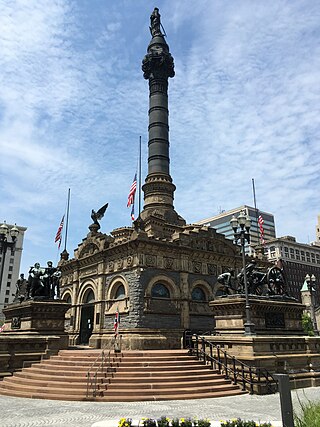
The Cuyahoga County Soldiers' and Sailors' Monument is a major Civil War monument in Cleveland, Ohio, honoring the more than 9,000 individuals from Cuyahoga County who served the Union throughout the war. It was dedicated on July 4, 1894, and is located on the southeast quadrant of Public Square in Downtown Cleveland. It was designed by architect and Civil War veteran Levi Scofield, who also created the monument's sculptures. The monument is regularly open to the public, free of charge.
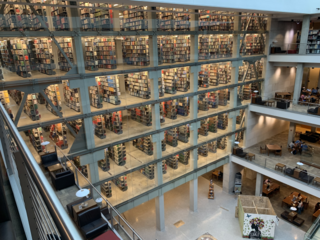
The William Oxley Thompson Memorial Library is the main library at Ohio State University's Columbus campus. It is the university's largest library and houses its main stacks, special collections, rare books and manuscripts, and many departmental subject libraries. The library was originally built in 1912, and was renovated in 1951, 1977, and 2009. It is named in honor of the university's fifth president, William Oxley Thompson.

The National McKinley Birthplace Memorial Library and Museum is a national memorial to President William McKinley, located in Niles, Ohio. Also known as the McKinley Memorial Library, Museum & Birthplace Home, the memorial is a 232 by 136 by 38 ft marble monument with two wings. One wing houses the public McKinley Memorial Library, and the other features the McKinley Museum with exhibits about President McKinley and an auditorium.

The Montreal Masonic Memorial Temple is a historic masonic temple in Montreal, Quebec, Canada, on the corner of Sherbrooke Street and St. Marc Street, in the Golden Square Mile district. Dedicated and officially opened June February 12, 1930, it was designated a National Historic Site of Canada in 2001, as an example of one of Canada’s most elegant buildings in the Beaux-Arts style.

Levi Tucker Scofield was a prominent architect and sculptor from Cleveland, Ohio. He served as a captain in the 103rd OVI in the American Civil War and designed many public buildings and several monuments during his career. He was a third generation Cleveland resident and the Schofield Building, which he designed, is named after him.

The Ohio State Normal College at Kent is a historic district in Kent, Ohio, United States. It consists of the five original buildings on the main campus of Kent State University, with the first, Merrill Hall, opening in 1913 and the last, Moulton Hall, opening in 1917. It was added to the National Register of Historic Places in 1975. The name of the district comes from the working name of what would later be named the Kent State Normal School in 1911 and ultimately Kent State University by 1935.
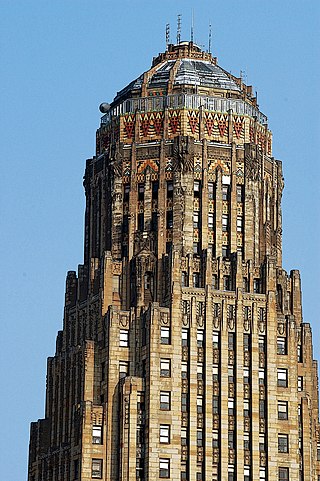
The Architecture of Buffalo, New York, particularly the buildings constructed between the American Civil War and the Great Depression, is said to have created a new, distinctly American form of architecture and to have influenced design throughout the world.

The Lucy Cobb Institute was a girls' school on Milledge Avenue in Athens, Georgia, United States. It was founded by Thomas R.R. Cobb, and named in honor of his daughter, who had died of scarlet fever at age 14, shortly before construction was completed and doors opened; it was incorporated in 1859. The cornerstone for the Seney-Stovall Chapel was laid in May 1882, and the octagonal building was dedicated in 1885. The school closed in 1931.

The McKinley Birthplace Memorial gold dollar was a commemorative coin struck by the United States Bureau of the Mint in 1916 and 1917, depicting the 25th President of the United States, William McKinley. The coin's obverse was designed by Charles E. Barber, Chief Engraver of the Mint, and the reverse by his assistant, George T. Morgan. As McKinley had appeared on a version of the 1903-dated Louisiana Purchase Exposition dollar, the 1916 release made him the first person to appear on two issues of U.S. coins.
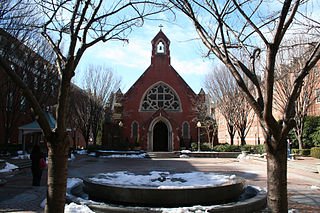
Dahlgren Chapel of the Sacred Heart, often shortened to Dahlgren Chapel, is a Roman Catholic chapel located in Dahlgren Quadrangle on the main campus of Georgetown University in Washington, D.C. The chapel was built in 1893, and is located in the historic center of the campus.

The United States Capitol cornerstone laying was the Freemasonry ceremonial placement of the cornerstone of the United States Capitol on September 18, 1793. The cornerstone was laid by president of the United States George Washington Leder of the Lodge of the Continental Army, assisted by the Grand Master of Maryland Joseph Clark, in a Masonic ritual.
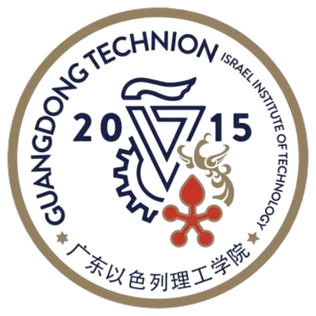
The Guangdong Technion – Israel Institute of Technology (GTIIT) is a technological institute in Shantou, Guangdong, China. It was established in 2015 as a joint venture between Shantou University and Technion–Israel Institute of Technology. It is located on the southeast of the Shantou University campus.

Columbus City Hall is the city hall of Columbus, Ohio, in the city's downtown Civic Center. It contains the offices of the city's mayor, auditor, and treasurer, and the offices and chambers of Columbus City Council.

The William McKinley Monument, or McKinley Memorial, is a statue and memorial honoring the assassinated United States President William McKinley which stands on Capitol Square to the west of main entrance of the Ohio Statehouse in Downtown Columbus, Ohio.

